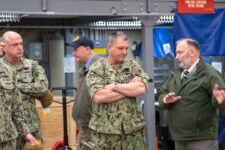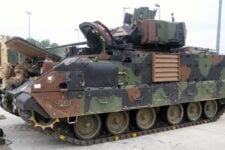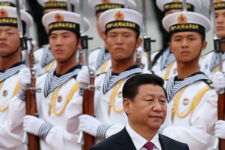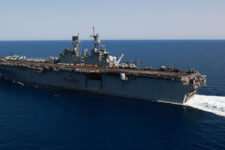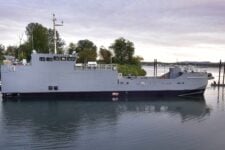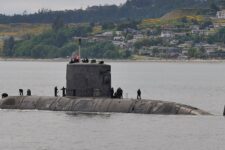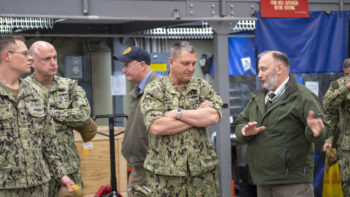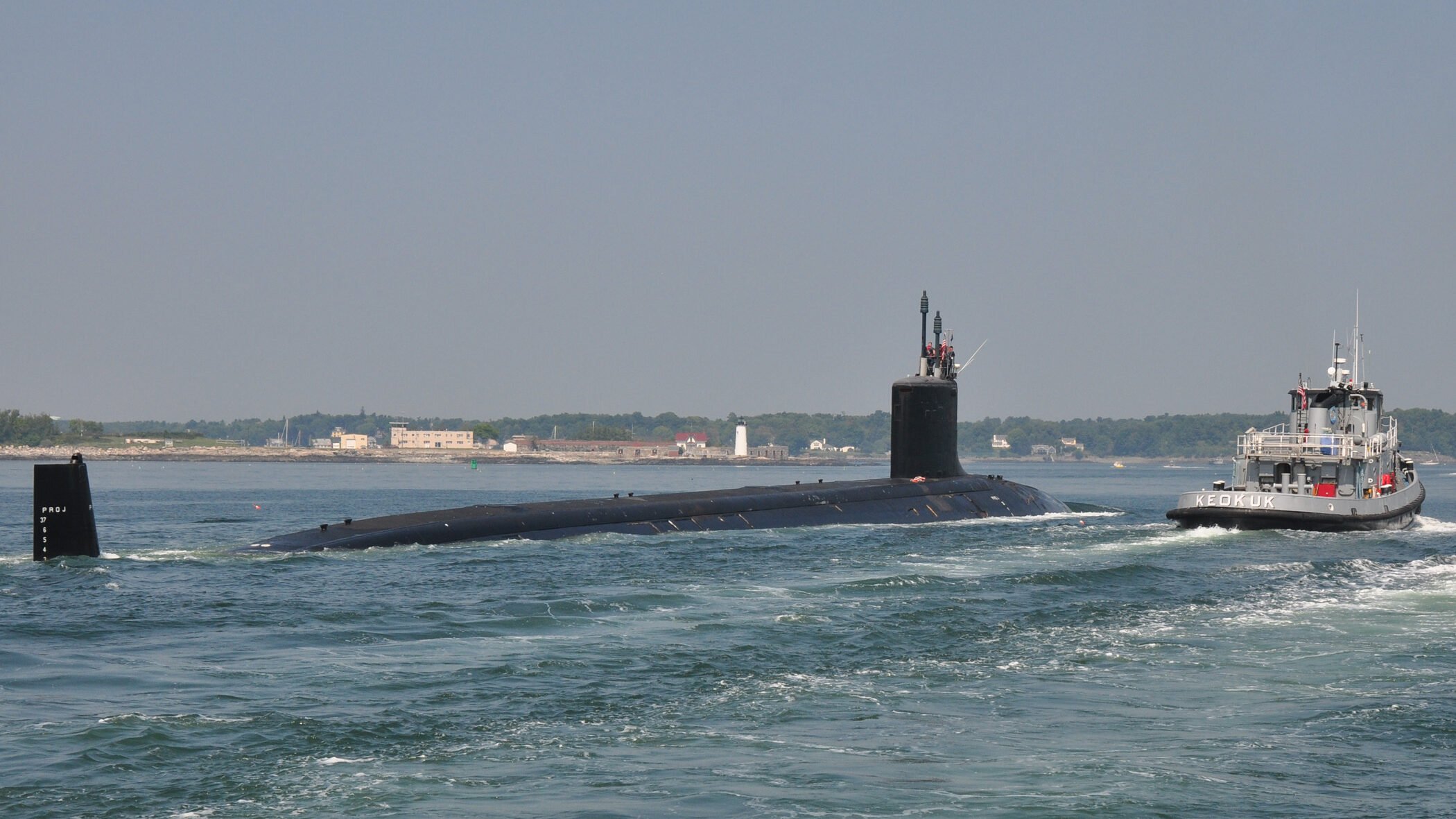
If funded, the Sea-Launched Cruise Missile-Nuclear would provide a low-yield nuclear weapon available for attack submarines like the USS Virginia, pictured here. (US Navy)
The debate on whether to develop a new nuclear sea-launched cruise missile (SLCM-N) has been a back-and-forth topic for several years. In this new op-ed, Kyle Balzer of the American Enterprise Institute argues that Congress must continue to support the development of the system, with China in mind.
The United States is ill-prepared to deter a potential existential military threat to the homeland: A regional nuclear war that escalates to a large-scale, catastrophic exchange. Indeed, as the bipartisan Strategic Posture Commission warns, the US defense posture requires broader nuclear options to insure against this specific contingency.
When congressional hearings open this spring on the budget and defense posture, this issue deserves urgent attention given the emerging two-peer nuclear threat environment. Luckily, there is a clear answer to America’s posture problem, already under development: the nuclear sea-launched cruise missile (SLCM-N).
Russia has a nuclear weapons employment doctrine that envisions limited nuclear use to dictate the terms on which a conflict is fought or terminated. Russian doctrine, in turn, is supported by a conventional posture embedded with thousands of theater nuclear weapons. Many of these lower-yield warheads are designed for survivable and precise delivery systems like road-mobile missile launchers — the hallmark of a limited employment capability. Russia’s full-scale invasion of Ukraine has revealed Putin’s willingness to run enormous risks, which suggests that in a future conflict with NATO, he might consider limited nuclear use an asymmetric advantage.
Given the rapid growth and sophisticated character of China’s regional nuclear potential, it is prudent to hedge against Beijing adopting a similar employment doctrine in the future. (DoD’s most recent China Military Power Report, for instance, indicates that PRC military officers are debating whether “new precise small-yield nuclear weapons could possibly allow for the controlled use of nuclear weapons, in the warzone, for warning and deterrence.”) Such a contingency is of grave concern in light of China’s desire to isolate Taiwan and decouple the US military from the Asia-Pacific. Indeed, in the 1996 Taiwan Strait Crisis, when China lacked a low-yield, long-range precision-strike capability, Beijing reportedly issued nuclear threats in an attempt to forestall a US show of force.
Though it ultimately failed to prevent two US carrier battle groups from entering the region, China now possesses the capability to conduct limited nuclear attacks across the entire Asia-Pacific.
In light of the emerging two-peer threat environment, the United States must do more to both extend deterrence to far-flung allies and, if deterrence should fail, avert limited nuclear escalation. It must convince Russia and China that they cannot successfully engage in nuclear blackmail or escalate their way out of a failing conventional war.
The current US nuclear posture is necessary but insufficient to credibly fulfill this mission. Strategic nuclear forces, given their remote basing arrangements, lack the ideal levels of flexibility and responsiveness. Moreover, the theater nuclear posture in Europe relies on dual-capable fighter aircraft, which are more vulnerable either to preemptive attack or integrated air defenses. And the Asia-Pacific currently lacks the infrastructure to service a permanent forward-based nuclear mission. Even so, such a posture would suffer from the same vulnerabilities as the basing system in Europe.
A more credible nuclear posture thus requires four characteristics: 1) an enduring regional presence; 2) the promptness to respond for operational effect; 3) widespread deployment to increase overall force survivability and complicate adversary planning; and 4) the ability to penetrate air and missile defenses within the threat-engagement envelop. The SLCM-N is the only in-design system that encompasses all of these attributes.
If deployed on attack submarines, SLCM-N will have an enduring presence in the North Atlantic, Arctic Ocean, and Asia-Pacific — whether it is actually patrolling a forward area or not. Due to the low observability of undersea launchers, Beijing and Moscow will have to assume it is loitering on site. SLCM-N would also enjoy unparalleled survivability; have the ability to promptly respond for military effect; and will be able to conduct missions in dense anti-access/area-denial zones. If deployed on select surface ships as well as submarines, the deterrent effect could be even greater. Indeed, these distinctive attributes have convinced senior military officials and a range of former civilian defense officials to repeatedly endorse the program.
The Biden administration’s opposition to SLCM-N, which it considers redundant and costly despite the program’s bipartisan support, is a grievous error.
The administration’s first criticism is that the system is redundant. As mentioned above, that is simply not the case. If a conflict has gotten to the point that nuclear weapons are in play, nuclear-capable bombers will likely be in high demand for conventional missions. And the W76-2 low-yield warhead, deployed on ballistic missile submarines, was only produced in small numbers for an even smaller set of launchers on alert at any given time.
On the administration’s concern for the $10 billion cost estimate for the 2023-2032 period, one might ask: What is the value of deterring the most likely existential military threat to the United States?
SLCM-N would certainly mean less missile launch tubes devoted to conventional weapons, as well as additional costs to certify submarine crews for the nuclear mission. The attack submarine fleet, however, would not necessarily have to devote a large number of launchers to the nuclear mission. Again, China and Russia would have to assume SLCM-N’s presence — whether or not it is deployed, in great numbers, to forward areas. In this sense, there is considerable deterrence value and cost-effectiveness in ambiguity.
SLCM-N, therefore, represents a comparatively modest expense to insure against the greatest military threat to the homeland: a regional conflict that escalates to large-scale nuclear warfare.
Kyle Balzer is a Jeane Kirkpatrick Fellow at the American Enterprise Institute, where he focuses on nuclear strategy and policy
Navy taps Pappano, long-time sub manager, as new acquisition advisor
Pappano’s years of experience in working with the submarine industrial base will likely be crucial to helping the service’s senior civilian work through AUKUS.
